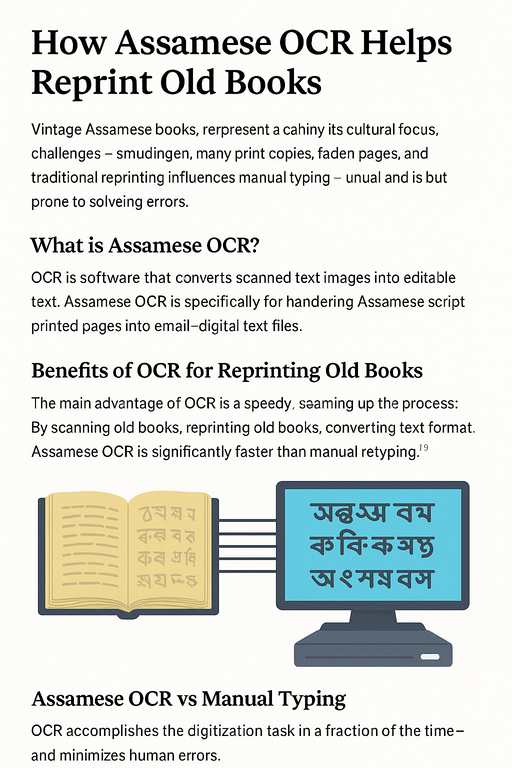How Assamese OCR Helps Reprint Old Books

How Assamese OCR Helps Reprint Old Books
Preserving the past with the power of modern technology
Old Assamese books are treasures — they hold stories, knowledge, culture, and history that shaped generations.
But many of these books printed decades ago are now fragile, faded, or out of circulation. When someone wants to reprint them, the biggest challenge is this:
👉 You don’t have the editable text.
You only have old, printed pages.
Traditionally, people retype these books manually — line by line — which takes weeks or even months, and is prone to spelling mistakes.
This is where Assamese OCR completely changes the game.
What Exactly Is Assamese OCR?
OCR stands for Optical Character Recognition.
It is software that takes a scanned image of text — for example, a page from an old Assamese novel — and automatically converts it into editable digital text.
Assamese OCR is specially designed to understand the curves, shapes, and matras of the Assamese script.
So instead of typing everything again, you simply scan → convert → edit.
Why OCR Is a Breakthrough for Reprinting Old Assamese Books
1. Saves Weeks (Sometimes Months) of Typing
Retyping 300 pages manually can take:
- 3–5 weeks for a professional typist
- Even longer if the text contains poems, uncommon words, or older Assamese fonts
OCR finishes this in minutes.
Even if you need to fix small mistakes, you save 95% of the effort.
2. Keeps the Original Style Intact
When you type manually, there’s always the risk of:
- Mis-typed words
- Wrong spellings
- Missed lines
- Lost sentence breaks
OCR preserves:
- Original words
- Formatting structure
- Paragraph spacing
This makes reprinting faithful to the original book.
3. Works Even on Old or Faded Prints
Modern Assamese OCR (like JAHNABI DRISTI) can handle:
- Lightly faded pages
- Yellowed paper
- Slight distortion
- Smudged ink
As long as the text is somewhat visible, OCR picks it up with impressive accuracy.
4. Makes Digitization Possible
Once the text is digital, you can:
- Store it safely forever
- Convert it to Unicode
- Publish in eBook format
- Create audiobooks
- Share with researchers or students
- Print fresh new copies
It’s like giving a second life to old literature.
5. Brings Down Reprinting Cost Dramatically
Manual typing is expensive.
OCR cuts the cost by:
✔ Reducing labour
✔ Reducing time
✔ Reducing proofreading work
For publishers, this is a massive advantage.
Assamese OCR vs Manual Typing: A Quick Comparison
| Task | Manual Typing | Assamese OCR |
|---|---|---|
| Speed | Very slow | Very fast |
| Accuracy | Depends on typist | High (with corrections) |
| Cost | High | Much lower |
| Effort required | Heavy | Light |
| Suitable for large books? | Difficult | Perfect |
OCR doesn’t replace humans — it boosts them.
You only spend time editing instead of typing everything from scratch.
Conclusion: OCR Is the Future of Assamese Book Preservation
With tools like DRISTI Assamese OCR, reprinting old Assamese texts has become smoother than ever.
It helps:
- Publishers
- Libraries
- Researchers
- Cultural preservation groups
- Individuals preserving family archives
What once took weeks now takes hours.
Assam has thousands of valuable books waiting for revival — and OCR is the fastest, most accurate, and most affordable way to bring them back to life.
If you want, I can also:
✅ Generate a second blog post (“Assamese OCR vs Manual Typing – Real Time Savings”)
✅ Create three more custom images in the same style
✅ Produce a SEO-optimized meta title + description for Astro